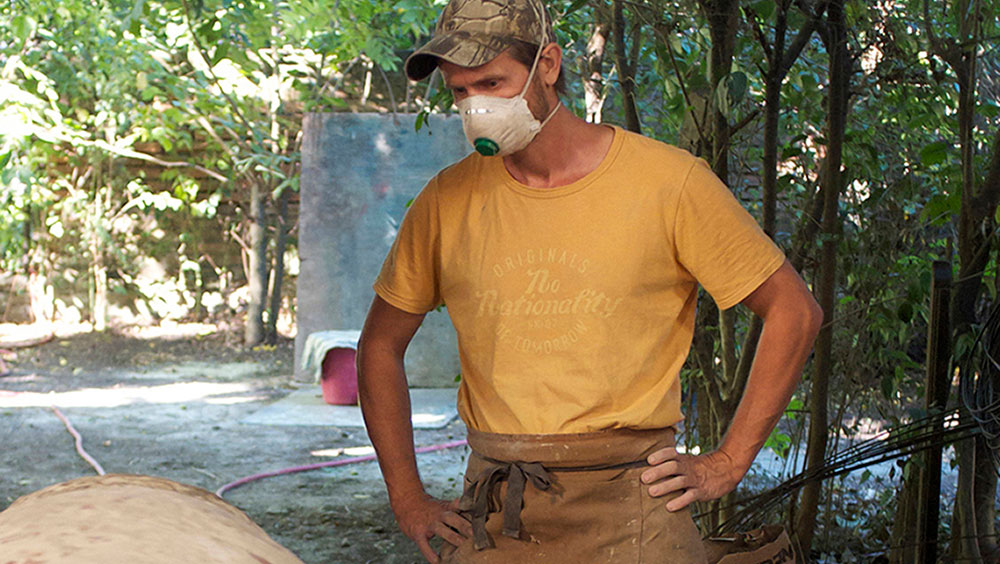
Adam Jeppesen in his studio, Villa Ruiz, Argentina. Photo: Charlotte Haslund.
by NICOLA HOMER
The Danish artist Adam Jeppesen (b1978) started his career in television and documentary-making, and then embarked on an artistic journey. He gained international recognition with his Wake series, inspired by the backwoods of Finland, which was published as a book by Steidl in 2008. When the National Museum of Photography in Copenhagen asked him to make works for a show, he drew on his fascination with the idea that it would be possible to drive all the way from the northerly point of Alaska to the tip of South America. Jeppesen’s subsequent work was the result of a solitary 487-day journey from the north pole to Antarctica, called The Flatlands Camp Project.
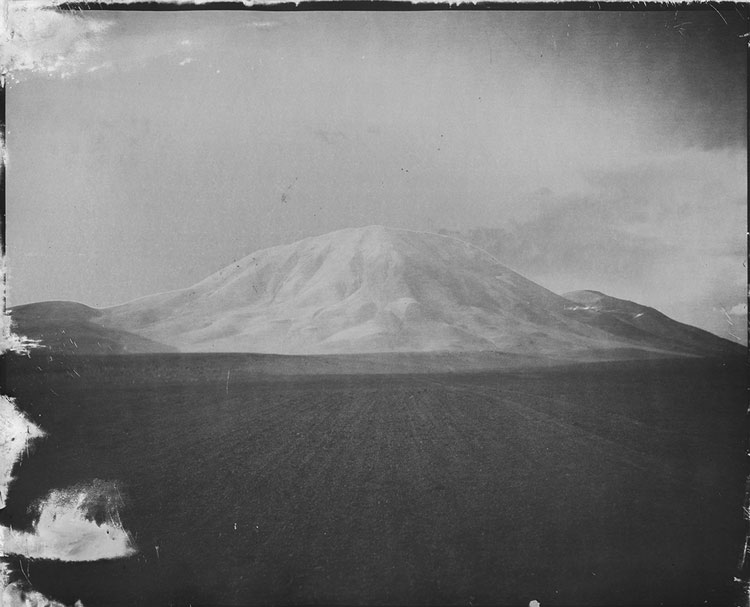
Adam Jeppesen. Incahuasi, 2016. Photocopies, straight pins, acid-free paper, framed 221 x 179 cm. © the artist.
He has exhibited work at a number of international institutions, including Foam in Amsterdam, C/O Berlin, Denver Art Museum, and the Brandts Museum and the National Museum of Photography in Denmark. He is participating in an exhibition this autumn at the Museo Provincial de Arte Contemporáneo Mar in Argentina – which is part of the Bienalsur 2021. Jeppesen spoke by phone to Studio International in advance of the opening of his new solo exhibition at Black Box Projects, Cromwell Place, London. This is an edited excerpt from that conversation.
Nicola Homer: How did you arrive at the decision to become an artist, as I gather that you previously worked as a documentary-maker for TV and film, and how did this influence your artistic career?
Adam Jeppesen: My background is in documentary and television. I worked mainly as a cameraman on different projects, most of which were fairly low budget. I worked on a series about the rights of indigenous people. I worked in conflict zones in Palestine and was in west Africa. On many projects, I either worked alone or on a small team, and most of the time, when returning home from this type of a job, I would hand over all the material, and an editor would put together their version of the story, which, in all honesty, didn’t correspond with my experience. So, early in my career, I began to bring a camera with me for shooting still images.
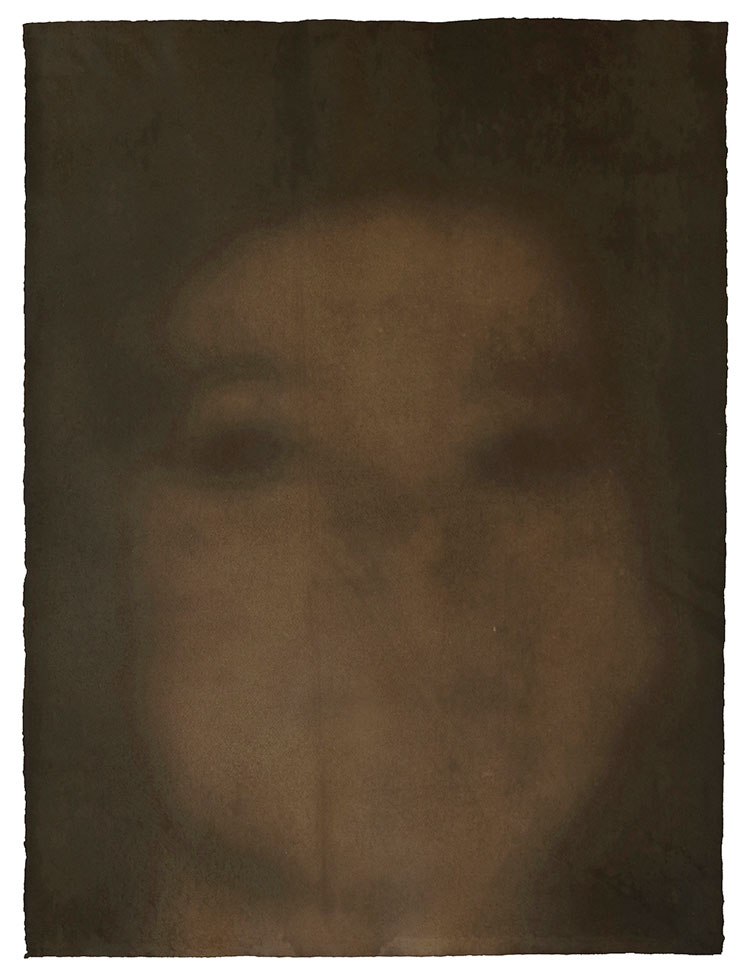
Adam Jeppesen. Lydia T, 2021. Anthotype on paper, 56 x 76 cm. © the artist.
Often when you film, you are acting and reacting intuitively, and I would find that my memory of what I had experienced was limited. So, I brought a camera along, to be an addition to my memory. As my career went on, I started noticing that the types of projects that had been funded previously were not the types that were now getting funding. There was a shift in Denmark, which is where I was mainly working for Danish production companies and for Danish national TV, to work being produced that was more entertainment-based. It lacked the depth that I had appreciated from making proper documentary work.
I took the decision, in about 2004, following years of having gathered this material, and also, when I was not in production, going out and shooting my own work, to carve out some time for myself and isolate myself with this material in order to edit it and see what would come out of it. The result was a book published by the German publishing company Steidl, in 2008, called Wake. It consisted of work I had been shooting. I wanted to express something that lay below the surface of what you initially saw, about the solitude, the more human aspect of many of these stories, and not just the factual aspect. It was important for me to place these still images in a body of work, and it was quite rewarding to do that book. It opened my eyes to this idea that maybe there was value in making my own work and setting time aside for my artistic career.
About four years after I had done that project, I began playing with the idea of properly taking time out to work on my own projects. I had shown some work and had been in touch with the National Museum of Photography in Denmark, which was interested in doing an exhibition with a specific still series of images that I had worked on: these were night-time exposures of large desolate landscapes, which required a full moon to do the exposure. Naturally, there were only a certain number of days a year that I could photograph, because it would take a fair amount of time to get into these landscapes, and then to time it around a full moon, and to cross fingers that the weather was going to be stable. The museum had asked if it could have around 15 images for the show and I calculated that it would take around a year to do this project.
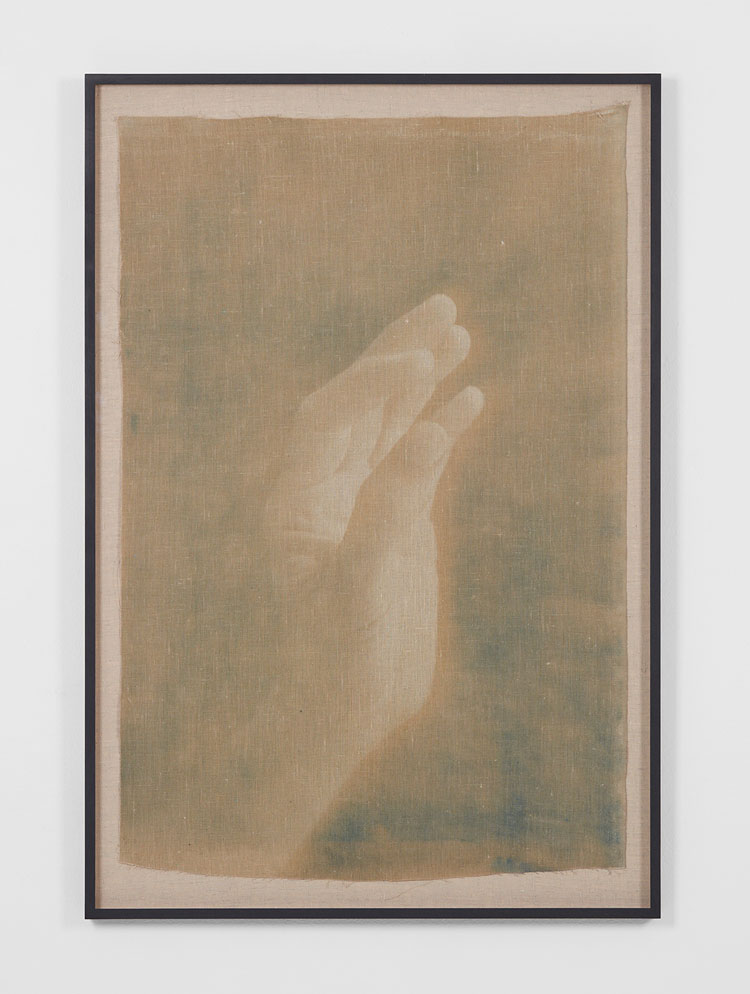
Adam Jeppesen. Work no. 127, 2018. Cyanotype on linen, 120 x 83.5 cm. © the artist.
A side story to this is that I grew up in New York. I was born in Denmark, but we moved to the US when I was about six, where I lived until the age of 14. Some very fundamental years of my youth were spent in New York and in the US. I had always been fascinated by this idea that you could, on the North American continent, drive all the way up to the tip of Alaska, and without leaving the ground, you could drive down to the tip of South America. That fascination that this was possible has stayed with me. So, when I was asked to do this exhibition, it dawned on me, that this might be my chance to live out this dream. When I had made that decision, it seemed easier to explain a proposal for such a project if it went from the north pole to the south pole, as that’s an easier A to B. So, that defined the passage that I wanted to make. I spent about a year trying to fundraise the money I needed to do this project. I estimated it would take up to two years to complete, and I set off, if I’m not mistaken, in July 2009. I was able to get on board a research vessel that was doing studies in the Arctic Sea and was going to the north pole. When I reached the north pole, I started my clock and from there on it was about a year and a half – 487 days, I think – until I reached Antarctica. I got as far south as I possibly could. I was never able to reach the south pole station – it was far more complicated getting to Antarctica if you’re not going there as a tourist or for proper research – but I was able to make it to Antarctica and that seemed to be the end of the road.
NH: Why did you decide to make this journey?
AJ: It’s kind of old school, but you were sent out to do this artistic work, that in my case was for this museum, for this exhibition. That was what set everything in motion. Before this trip, my practice was based around the perfection of the photographic image. It was just the pure nature of how I was travelling; it was all land-based. I had a car in the beginning, but I soon got rid of that, and I crossed the US on a bicycle. Living in those circumstances, whether you’re hiking, walking, or on a bicycle, you’re travelling with what you can carry, and if you are shooting analogue photography, dust, dirt and impurities get into the film and the camera. When I returned from this trip, it didn’t take long for me to realise that, if I am to be honest with my work, and honest about this experience – and this work is not about these perfect images I wanted to take, this is about the experience of what this journey has been like – I need to include this work. At that point, I began the process, which I still embrace, about imperfection and a more realistic view of how the world is, which includes these scars and this stuff and the dirt.
My editing ended up being a process that took a lot longer than the journey itself, and in a certain way became much more important to my artistic practice. I spent the greater part of five, six, seven years reviewing that work, and finding different series hidden beneath the work and within the work, and almost sifting through it as you would sift through someone else’s work that you have access to. A lot of the time it felt like that.
NH: That’s amazing. I can imagine you have a universal approach to landscape, and the images you have captured have a sense of mystery. How have you been inspired by the landscape and what are your favourite types of landscape?
AJ: I have been drawn to these desolate landscapes. I spent a great part of this trip in the Altiplano, which is a high-altitude plain around Bolivia and Peru. There is nothing but shrubs and grass, and it’s quite flat, and even that is inspiring, but, again, it comes back to the fact that it is perhaps more inspiring on a personal and human level. It’s more your interaction with the landscape that brings out the fascination rather than the landscape of which you’re in awe.
NH: Now in the artistic tradition of landscape, you find people looking at the theme of road trips, for example the writer Jack Kerouac, who wrote the novel On the Road (1957) and produced visual works. Have you drawn inspiration from specific artists in your artistic career?
AJ: I’ve drawn inspiration less on an artistic level and more on a personal one, and those two things are interlocked within me. Before I had a consciousness of the fact that I was going to be working with my own art, I would read Kerouac, for example. And Wim Wenders made a very interesting book called Once, which is a photography book about places he has been to and people he has spent time with on the road. Earlier, I was fond of reading Haruki Murakami and going into that type of a universe. There is something beneath the facade of the landscape and of what we initially perceive. And you know that type of subtle thought, call it philosophy, is probably something that has inspired me more than the idea of the direct visual language of any particular artist. Several of his novels I find to be inspiring, and in that sense of bringing you into this other world that is somehow still parallel, or still overlapping with our world. Then another thing, which I appreciate very much, is music. Music has always been a very important driver, almost bringing out the visual in my own mind, and so I tend to use music quite a lot in my practice.
NH: Are there any specific musicians from whom you draw inspiration?
AJ: That’s a great question. When I was doing that trip, Bob Dylan was one of my favourite artists to listen to when I was driving across Canada. I’ve never been super into Dylan, but it seemed to be fitting in that space and that experience. But it was also that experience which kept me, I found, from photographing. I sold my car because I was enjoying so much driving to Dylan, and seeing the landscape and kind of getting lost in the road trip, and this was to be a productive trip. As soon as I sold it and began travelling by bicycle, the music also changed, and I didn’t listen to Dylan any more. Now a favourite artist to listen to while I work, because I spend a lot of time working in my studio rather than being in the field, is Nils Frahm, a German pianist. All his records are super beautiful.
NH: On the topic of Japanese culture, I gather you are interested in the Japanese philosophy of Wabi-sabi. I’ve read about your 2015 book, Flatlands, which features your travel photography, and how you appear to take this deliberately imperfect approach. Why are you interested in this philosophy of imperfection?
AJ: Well, Leonard Koren wrote a seminal work on Wabi-sabi, a philosophy that in Japanese culture is difficult to explain. You can’t really put it into words because it doesn’t convert the essence of it. In Denmark, we have this thing called hygge, which could be translated into a type of cosiness, and this has grown in popularity. People outside Denmark have got word of this concept, and you’re asked to explain it, and your words are not going to add up to the sum of what it actually is. Well, Wabi-sabi is similar to that. Following this trip, I embraced the imperfection in my work. It was like a light that went on in my head.
I have worked a lot on this idea that my work needs to be truthful, and when I have been teaching, I have kind of preached that, whatever it is that you do, always ask if what you’re doing and what you’re expressing is genuine. I’ve found that by embracing Wabi-sabi, and many of the concepts that lie within that, being the embrace of imperfection, and the consciousness of the ephemeral, and that nothing is to last, and everything is in constant change, I could resonate so much with that. All of a sudden, to discover this is a concept that goes back a very long time, and that I was just another drop in that ocean, was very invigorating. So, the book Flatlands wasn’t deliberately shooting for the imperfection, it was more editing without being scared away by the imperfection, thereby looking at whether the imperfection adds something that gets the viewer closer to understanding what it is that I want to express with these images, which are images about expressing the essence and the experience of solitude. That is something that, to this day, I still reference. In terms of the work of Koren, especially in that book, which is so beautifully explained, it is very much like a guide for me.
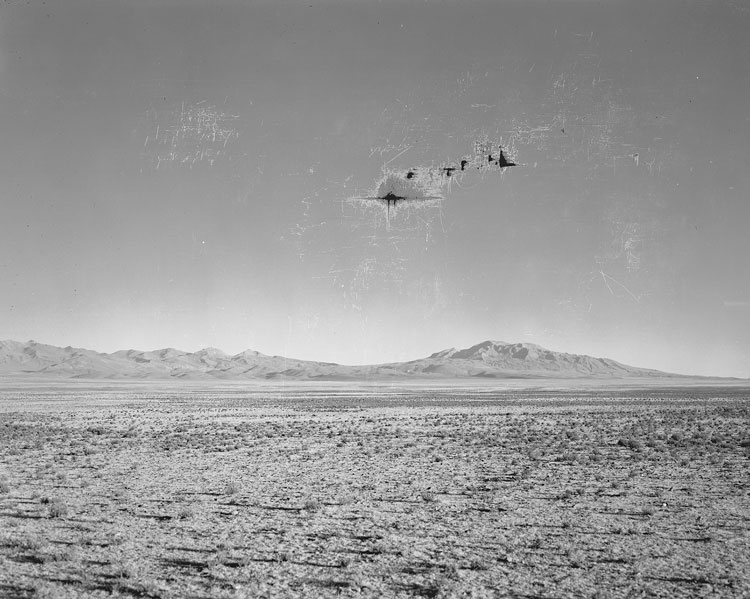
Adam Jeppesen. September 5th, 2013. Photogravure and letterpress on Somerset 400g, 8 parts, 74 x 49.5 cm each. © the artist.
NH: Could you give an example of one or two images that capture this approach?
AJ: There is one work called September 5th. It’s an image of a very desolate landscape with a mountain, hills rising up on one side, and then in the sky, there’s this triangular shape that could almost at first glance look like a UFO. But if you look closer, you’ll discover it’s just scratches in the image. That image was one of those that I would have discarded immediately, but once discovering that those scars and those scratches were created because of the journey, that they weren’t purposefully placed there, it was very much also this idea of embracing the things that are handed to you through chance and coincidence. It’s not an example of the aesthetic quality of what I find to be very beautiful around Wabi-sabi, but it’s an example of this idea of embracing the imperfection. Then my work around The Pond and the series of hands – on show at the Martin Asbaek Gallery in Copenhagen in 2017 – is a much more balanced expression of the imperfection alongside the beauty of what can be found in the imperfection, and the figural nature of materiality.
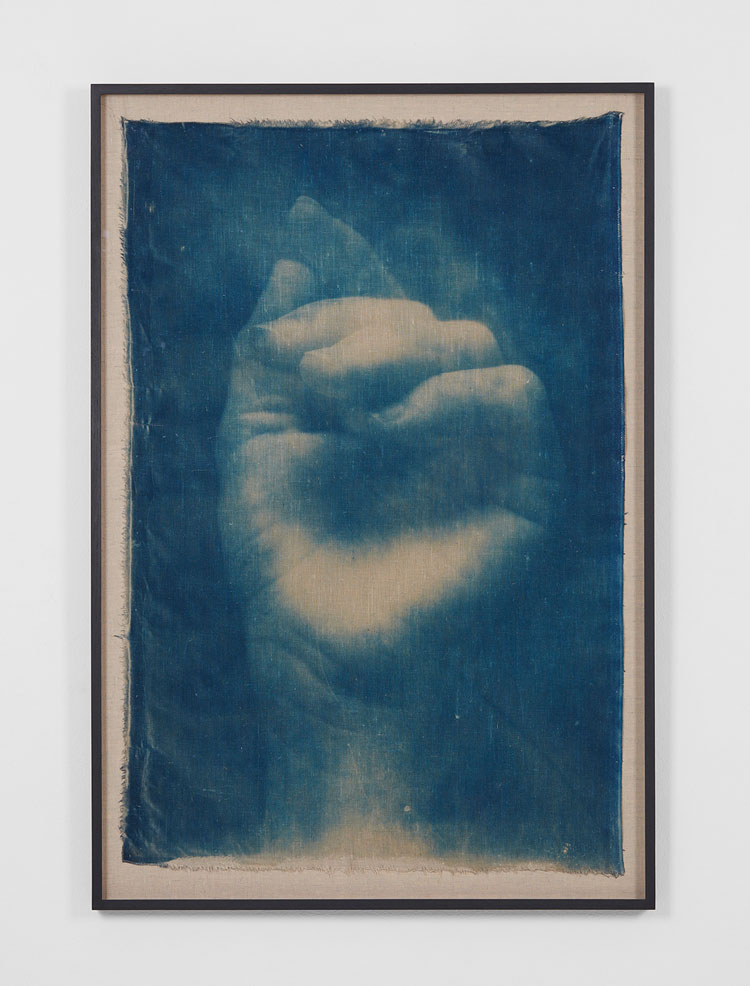
Adam Jeppesen. Work no. 126, 2018. Cyanotype on linen, 120 x 83.5 cm. © the artist.
NH: I enjoyed your solo exhibition at the Martin Asbaek Gallery. Now, I’d like to move on to your exhibition Evidence of Absence, which is being hosted by the gallery Black Box Projects at Cromwell Place in London this autumn. What is the significance of the title of the exhibition?
AJ: The exhibition consists of two different bodies of work. One of them comes from an exhibition I held at Brandts Museum in Denmark, in 2019, which is a very large, site-specific work called The Great Filter. The one in Denmark was a work that measured 60 metres by nine metres, consisting of sandcastle-like structures set from a common mould, but which are broken down and in a state of deterioration. The work consisted of about 25,000 of these structures, and it became this vast landscape/cityscape of this abandoned space with no sign of human activity, perhaps something which is sliding into history, as we would look at remains of other societies that have come before us.
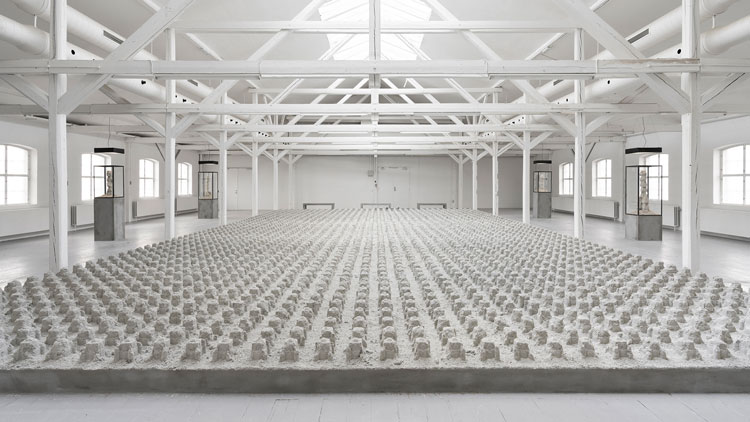
Adam Jeppesen, The Great Filter. A landscape of crumbling sandcastles and semi-collapsed shapes, 150 square metres. Installation view, Brandts, Denmark, 2019. Photo: David Stjernholm.
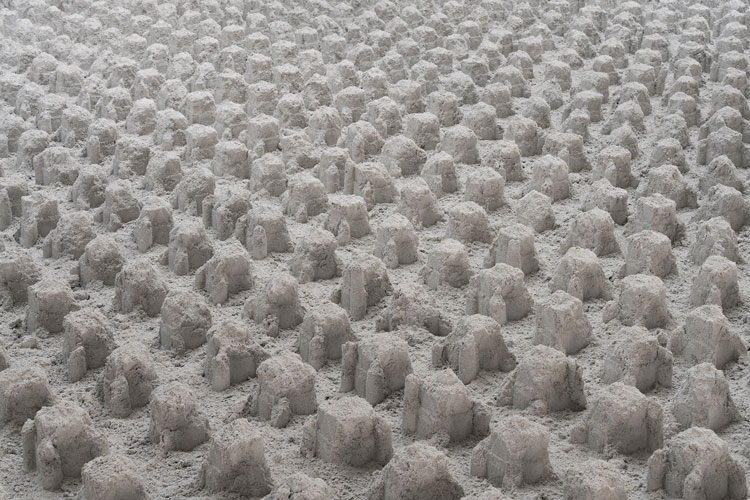
Adam Jeppesen, The Great Filter. A landscape of crumbling sandcastles and semi-collapsed shapes, 150 square metres. Installation view, Brandts, Denmark, 2019. Photo: David Stjernholm.
The Great Filter, the title of that show, was derived from this idea put forth by a British philosopher, I believe, around why is it that we have not seen any sign of life in the universe apart from our own. This is something that needs to be considered once we start looking at things like artificial intelligence and biotechnology, and how much influence that could have over the world as we know it today. Accompanying the large installation of the museum were towers made out of these structures. They are very fragile-looking sandcastles, set within vitrines. In reality, they are quite firm and kind of frozen in that moment. That’s one part of the exhibition. There is another work on the wall in that series.
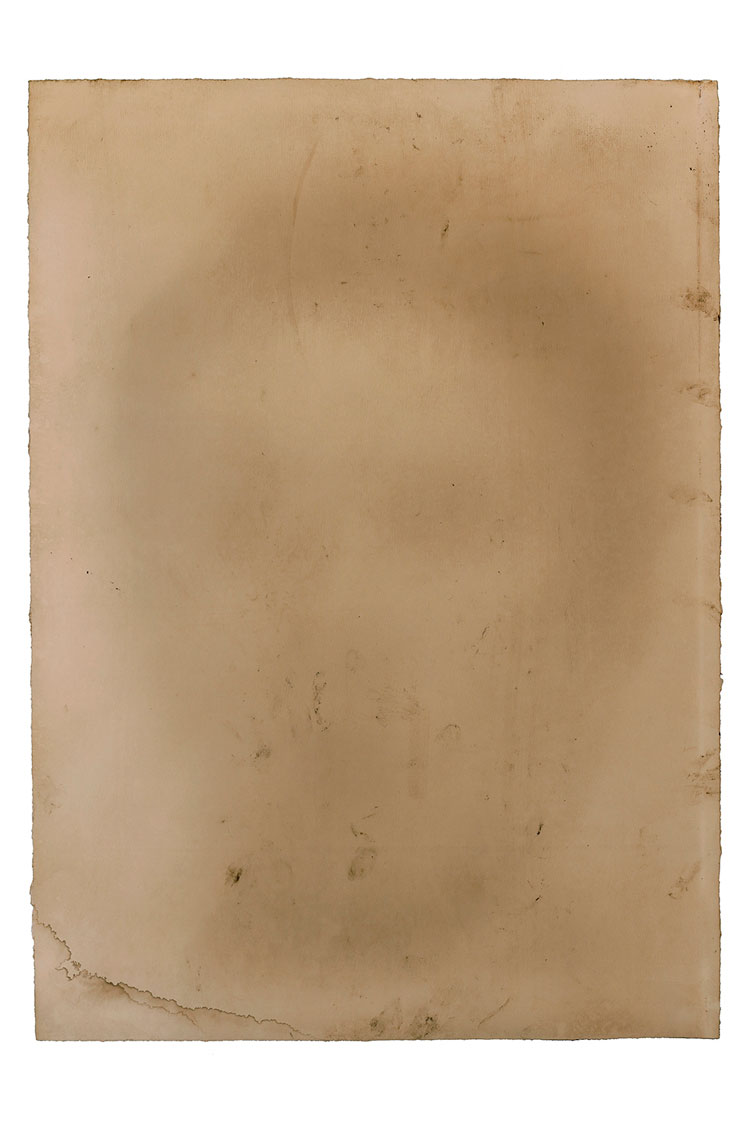
Adam Jeppesen. Terence D, 2021. Anthotype on paper, 70 x 96 cm. © the artist.
In the second room, there is a series of portraits, which I began working on during the pandemic. The portraits are created using artificial intelligence and they’re images of people who have never existed. They’re created from an algorithm, which basically is just from a large bank of material. Then, in juxtaposition and in contrast to that, I recreate images using a very old technique called anthotype. It’s a funny technique because you can’t fix it, and it has a life of its own. On the images, basically, you expose negatives from this artificial intelligence on to these papers. Through that exposure process, leaving them out in the sunlight, the sun bleaches the paper and the parts where there is no negative, and it creates the illusion that there is an image coming out. They’re very ghostly and hint at the existence of something, but at the same time it is not there. So, the exhibition’s title, the Evidence of Absence, is just that. Like all this work, it is about this idea that there is something there, and at the same time it is not something we can grasp. It’s something that we hint at, whereas the work from the Great Filter is something that was perhaps there, but now evidently is gone, and what is left is this shell.
NH: Can you single out any artworks in the show that convey central themes?
AJ: The anthotypes are ones that I personally lean towards because they have another depth. Some of them are so vague or blurry that you have to spend a fair amount of time until you start seeing the images. These types of images at first glance might just seem shadows and imperfections in the paper, but once you begin putting the pieces together, it is very easy to see the images. They reference the Shroud of Turin – this idea that there is an image embedded within this material, but you cannot make it out. In the case of the Shroud of Turin, it’s equally as difficult to find out how it was ever created. These papers have this feeling as well, that it’s a little difficult to place them, how they are made and what they consist of. For the anthotypes, I use a technique from the world of natural dying and tinting of fabric and wool. I pick leaves and boil them and, through that process, extract the colour from the plants I’m using. I place that into a large bath with my paper and let the pigments soak into the paper. It creates a somewhat imperfect expression, because very soon thereafter the process of decay begins. I try to work with this idea of the decaying material and how that influences and settles on to the paper.
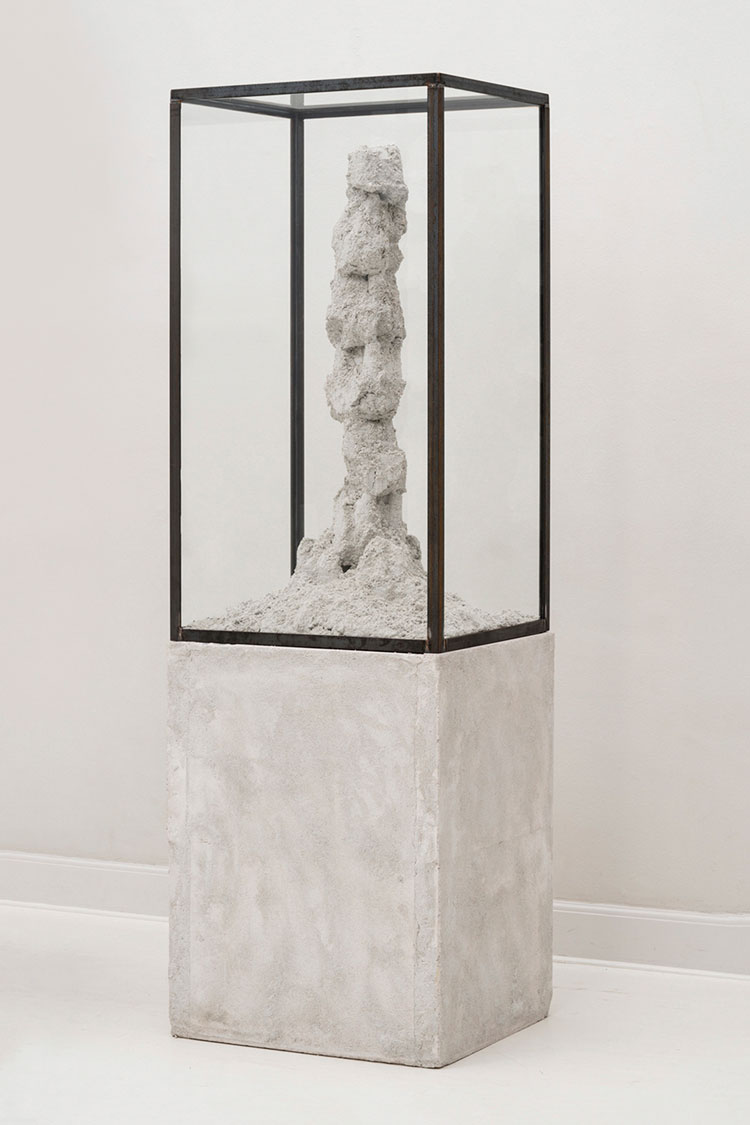
Adam Jeppesen. DK·CPH·CMT 2118, 2018. Cement, sand, steel, 110 x 60 x 50 cm. Installation view, Summer in the City, Martin Asbaek Gallery, Copenhagen, 2018. © the artist.
NH: That’s really interesting. Could you tell me a little more about the towers that will feature in the exhibition?
AJ: The towers are made in the same way as this large piece that I talked about. They are made by placing one mould on top of another. Within the towers, there is an iron centre, which holds everything together, and keeps it from collapsing. I use a very dry material, similar to beach sand, but it has hardener within it, so when it dries it is harder than beach sand would be. Once a tower has begun to dry, I place another one on top of it, and slowly that way, you sculpt these towers that have a certain height that becomes like their maximum. So, it’s trying to push the materials, to see how far I can push them before the whole thing begins to collapse.
With all my work, going as far back as these original pieces for this museum show, I’ve tried to put emphasis on the fact that the viewer interacts with my work, and not that the viewer becomes the passive bystander, just looking. With these towers, the idea is that visually, on first inspection, they’re identical. But once you, the viewer, begin to go around them and go closer, you find different stories hidden within them. The mould I used has certain architectural qualities, like remnants of other architecture. You can find a little doorway, or you can find a little tower, and you can almost begin to spin a story about what happened here, and what happened in this tower. But that really requires that you spend time with the work. In general, all the work I do, if there’s such a thing as slow art, this is it. You need to spend time to understand it, to be with it, it’s not something that just jumps out at you. For me, the power of this work comes from the investment of one’s own time with it as well.
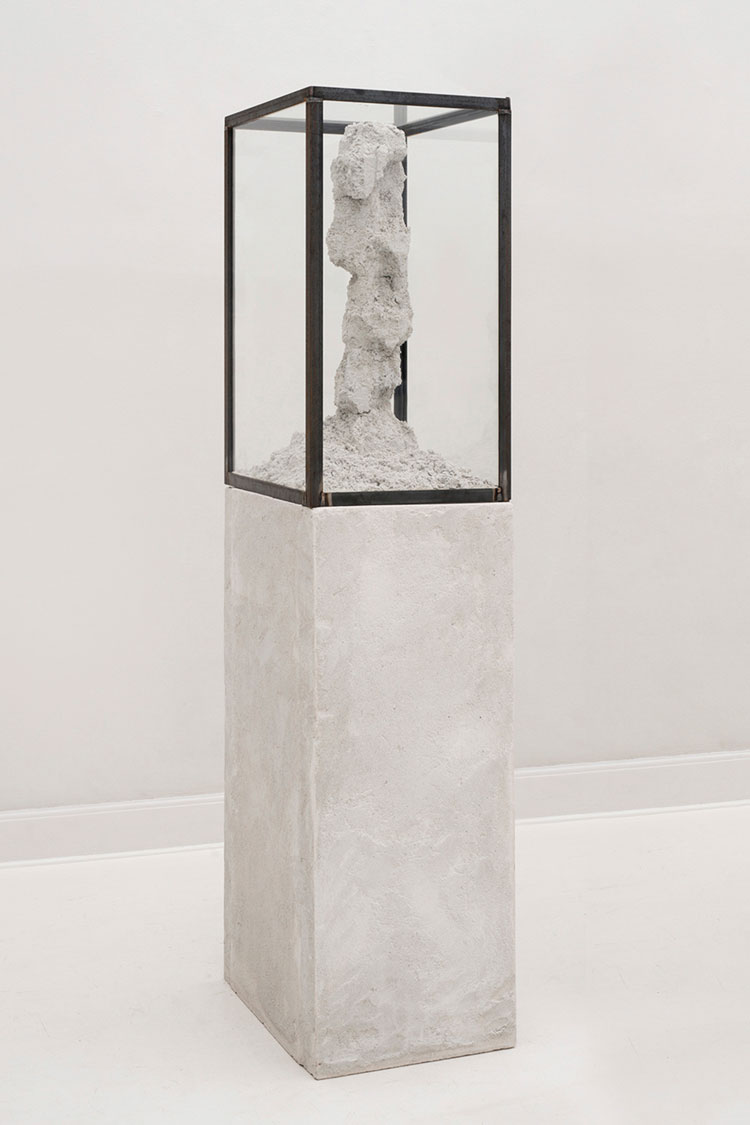
Adam Jeppesen. DK·CPH·CMT 37,8 18, 2018. Cement, sand, steel, 40 x 50 x 75 cm. Installation view, Summer in the City, Martin Asbaek Gallery, Copenhagen, 2018. © the artist.
NH: That’s fascinating. You suggested the viewer’s perspective. What do you hope that the viewer might draw from your exhibition?
AJ: I hope the viewer will draw some inner reflection and some reflection on the automatic way we go through life right now, of an over-fascination with technology. My other works have been very much about meditation, and about creating a certain meditative space that is quiet, that opens up for self-reflection. But in this new body of work – I guess I’ve never thought of this until you asked me – I would hope for more than just peace and quiet and self-reflection, and perhaps something that is more about questioning certain tendencies in the modern world, which seem to be at a hyper-speed of development. It requests that we question the direction that is going.
NH: That’s brilliant and very thoughtful. What’s next for you? What are your hopes for the future?
AJ: I would like to continue exploring the theme that I am on right now, and perhaps really extract the relevance of my work, and figure out how best to comment on this, without it becoming me lecturing or drawing conclusions, because I’m not in a position to do that. I lack the full scope. There is a research centre at the University of Oxford called The Future of Humanity Institute. There are some very interesting philosophers working there, with these questions, trying to bring them to the forefront of policymaking, to the degree of how climate policy was brought up in the late 1970s [the decade of the environmental movement]. They are arguing that lots of these other things are as important if not more important, to be questioning technology and where we are globally collaborating to make sure that we can safeguard humanity in the future. If, through my art, I could somehow be part of that conversation, I would love to and be honoured to. Lots of these are coming at it from a philosophy or a policy point of view. And what I think there is space for, a need for, is for us to do it from an artistic point of view, to come at this from all sides, because I think it is such an important thing in our world.
• Adam Jeppesen: Evidence of Absence is at Black Box Projects, Cromwell Place, London, until 17 October 2021.